If K-drama has taught me one thing, it is that Korean foods are a force to be reckoned with. You see it woven into the very fabric of Korean culture. Just like how Koreans use food to express affection, I will use this list as an invitation for you to try out Korean food.
When you have the chance to visit Korea, let this list be your guide on what to enjoy. Those suggestions go very nicely with memorable Korean drinks. How many of these fantastic foods have you known and tried?
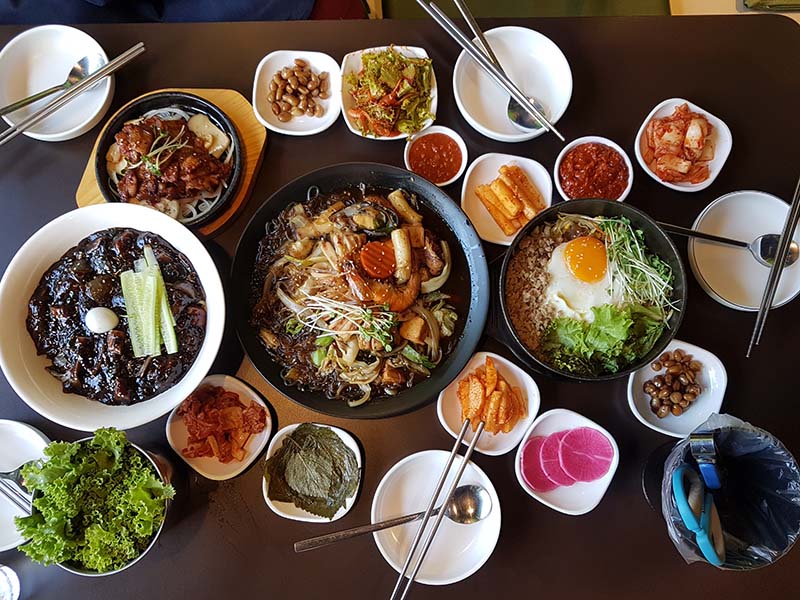
Experience Korean Style Fine Dining With These 13 Korean Dishes
I want to take you on a food tour through the vastly diverse world that is Korean cuisine. But before you dive in head-first, read up on some of the most popular Korean restaurant styles dishes. If you have never tried eating these Korean restaurant dishes, what are you waiting for?
1. Bibimbap – 비빔밥 (Korean Mixed Rice)
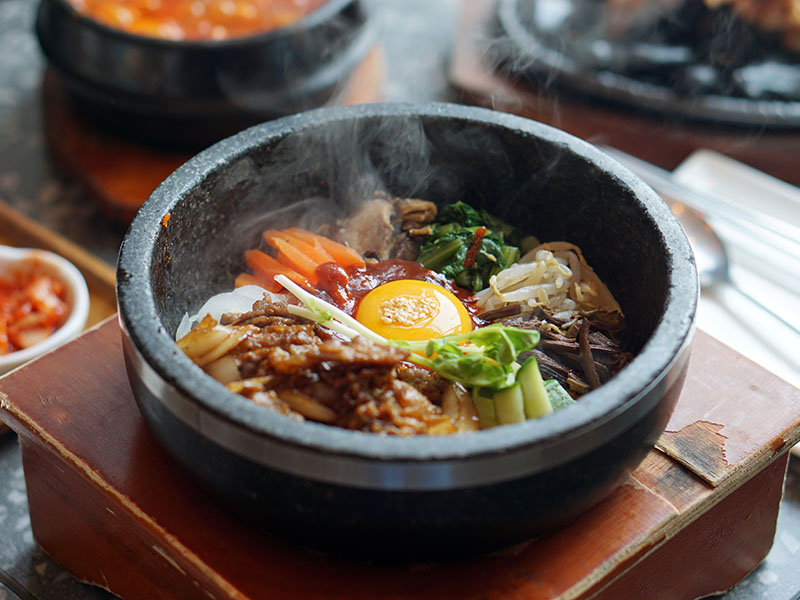
You have got to try this Korean mixed rice dish. Bibimbap translates to “mixing rice.” While there are endless possible combinations to the recipe of this dish, the main components are flexible, but there are also a few must-haves.
Fermented or sauteed vegetables, gochujang (red chilies paste), soy sauce, and various proteins are needed to make a good bowl of bibimbap. But you are more than welcome to put your spin on it.
The presentation of bibimbap is an artwork of color, flavors, and textures. And as bibimbap lives up to its namesake, you will want to mix everything together prior to eating it so that every bite gets a bit of every ingredient.
Bibimbap is an important part of Korean food culture.
2. Bossam – 보쌈 (Pork Wraps)
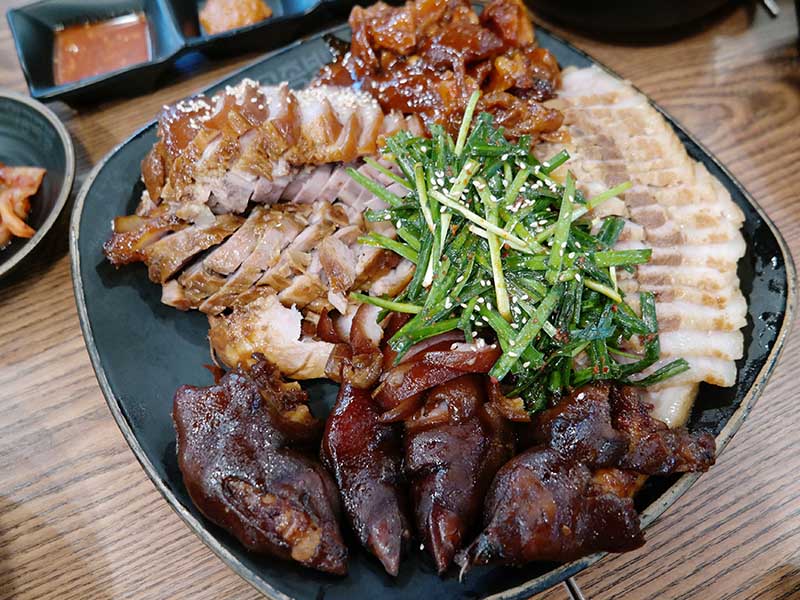
Bossam is a pork dish that can entertain a lot of people because eating it is a bonding experience. The name translates to “packaged” or “wrapped.” The reason is because that star of this dish is a complexly prepared cut of boiled pork.
The cook will wrap the pork in twine and boil it with a combination of various spices to enhance the flavor. The right way to preserve the shape is to drop the hot pork in cold water to flash cool. Korean people enjoy Bossam by combining this sliced meat with various side dishes.
You wrap the meat and side dishes with a piece of fresh lettuce and eat it as a sort of fresh dumpling. It is fresh and hearty at the same time, perfect for when the weather is hot.
3. Kimchi Jjigae – 김치찌개 (Kimchi Soup)

The term jjigae refers to a type of soup that is made with fermented vegetables and flavored with fermented paste. In the case of Kimchi jjigae, the main ingredient is, you guessed it, kimchi. You can eat it by itself or with white steamed rice.
Kimchi is a type of fermented Korean napa cabbage that is packed full of amino acids and probiotics. People prepare Kimchi Jjigae by stewing kimchi, beef, and gochujang (fermented red pepper paste) in a stone pot. It is the perfect cure for loss of appetite.
This is the Korean way of using up old overripe kimchi from last year. Simultaneously cleaning out the kimchi pots to make newer Kimchi this year. It is said that the older kimchi, the better because it becomes softer and richer in lactic acid.
4. Chueotang – 추어탕 (Mudfish Soup)
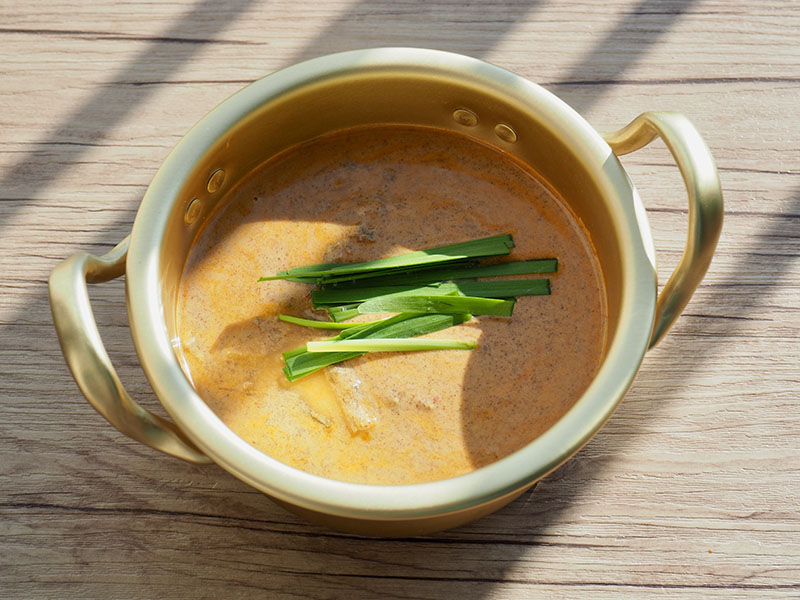
Chueo – tang is another type of soup that has made its way onto this list by being absolutely delicious. Chueo is a type of pond loach that becomes very tender and flavorful when cooked. Tang simply means soup. Hence the name Chueo-tang, which means loach soup.
In the period surrounding the spring equinox (March 20th to 21st), Korean people drain the rice pads after harvest. This is when loaches taste the best because they are at their most mature, yielding better flavor.
The ingredients of this soup are fairly simple, but each carries its own weight and contributes to the dish just as importantly. It usually consists of boiled and deboned loach, along with a mixture of gochujang, doenjang, ginger, and various other vegetables.
When the weather gets cold, Koreans enjoy eating Chueotang.
5. Ganjang Gejang – 간장게장 (Raw Marinated Crabs)
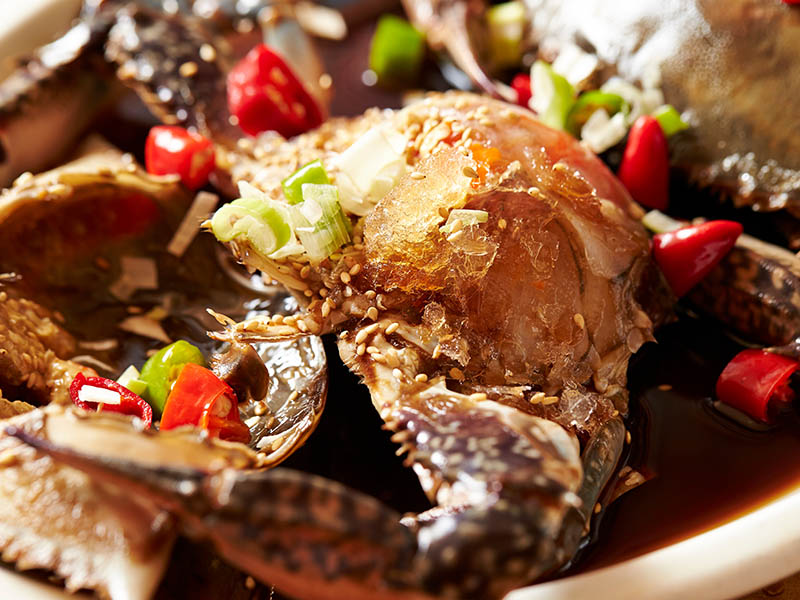
More often referred to as Gejang alone. This particular dish is not for the faint of heart but rather for those adventurous eaters. This dish gets its name from the word “ge” meaning crab and “jang” which translates to “condiment”.
This dish consists of marinating raw crab in a mixture of soy sauce and other seasonings. Korean recipes prefer female crabs because they are bigger and yield more roe. The extra meat takes on more flavor and improves the taste of the Gejang.
The traditional method of preparation instructs that you heat up the marinade before pouring the warm liquid onto the crabs. Once the marinade cools down, you should reheat it and pour it back onto the crabs. This step needs to be done several times.
6. Gogigui – 고기구이 (Korean BBQ)
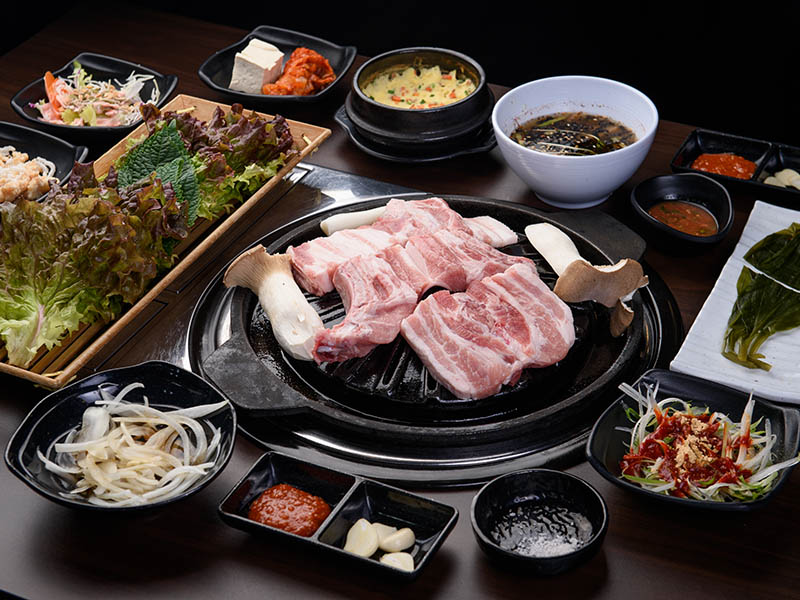
Now I know that a lot of the names on this list may be foreign to you if you are not well-versed in Korean food culture. But this particular dish has made its way across the globe as one of the most enjoyable Korean foods out there.
If you are thinking of Korean barbecue, then you are right. This usually consisted of grilling meat such as beef, pork, or chicken on a grill built into the table. You can enjoy this however you like. Traditionally, you can eat Gogigui with a variety of banchan, rice, and fresh vegetables.
Gogigui has become so internationally popular that you can usually find many franchised Korean BBQ restaurants in almost all major cities. In those places, you can find delicious food and spend quality time with your friends.
7. Jajangmyeon – 자장면 (Black Bean Noodles)

Jajangmyeon has a Chinese origin story. This dish came from the Chinese specialty Zhajiangmian, which is a type of noodle served in a fried bean sauce. Some might even argue that though they share an origin, they are different in many ways.
A Chinese immigrant and restaurant owner brought Jjajangmyeon over in 1905. Since then, Jajangmyeon has gradually gained more widespread popularity. Most recipes call for cooking pork and other diced vegetables in a sauce made with chunjang (sweet bean sauce).
This dish takes very little time to come together and is delicious to eat as a snack or a light dinner. The list of ingredients may vary from home to home but, two of its defining characteristics are the rich dark brown sauce and chewy, flavorful noodles.
Jajangmyeon is one of the 100 icons of Korean food.
8. Gomtang – 곰탕 (Oxtail Soup)

They are also known as Gomguk (곰국). This term refers to a particular type of soup made from many cow parts. In Korea, the chef primarily utilizes the boney, collagenous parts, which is why this soup may sometimes be called Ox Bone Soup.
If the Western or Vietnamese-style bone broth aims to make the liquid as clear as possible, this Gomtang expects you to do the exact opposite. You can make this at home by stewing the bones and briskets of the cow until the stock is rich and milky white.
This soup has several regional varieties, like Hyeonpung gomtang, made with the tail, feet, and entrails. Meanwhile, Naju Gomtang is made with the heel meat and brisket of the ox. The dish is further categorized by the list of ingredients that pair with the meat.
9. Japchae – 잡채 (Stir-Fried Cellophane Noodles)
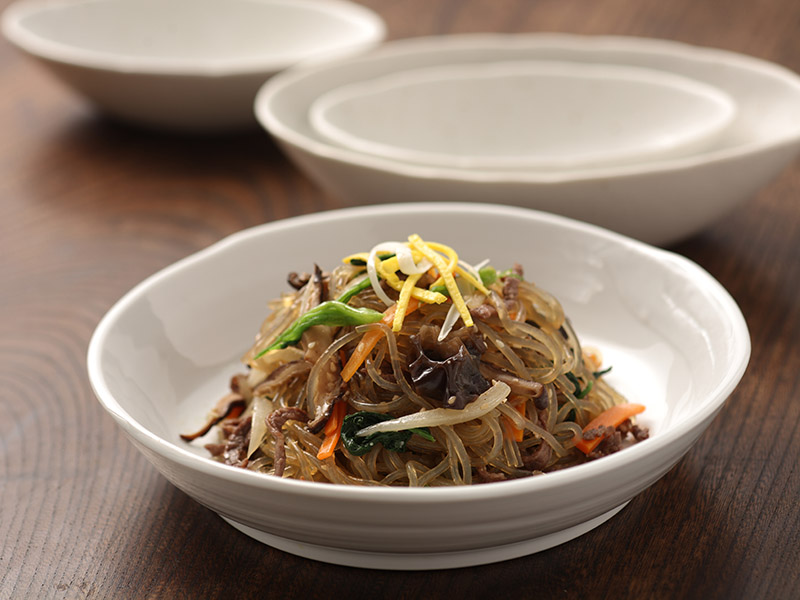
I may venture an argument by saying that Japchae is one of the most popular types of noodles in Korea come the holidays. This once royal dish is made by stir-frying cellophane noodles with an assortment of julienned vegetables and a mixture of soy sauce and sesame oil.
Sometimes, you may see it as a type of banchan (Korean side dishes). This tasty noodle dish is simple to make yet so intensely addictive. An additional bonus is that it takes very little time, effort, and ingredients to come together.
An important element that you need to keep in mind if you want to make Japchae is the type of noodle you are using. Noodles used to make Japchae are made from sweet potato starch to enhance flavor and chewiness.
10. Kal-guksu – 칼국수 (Knife-Cut Noodle Soup)
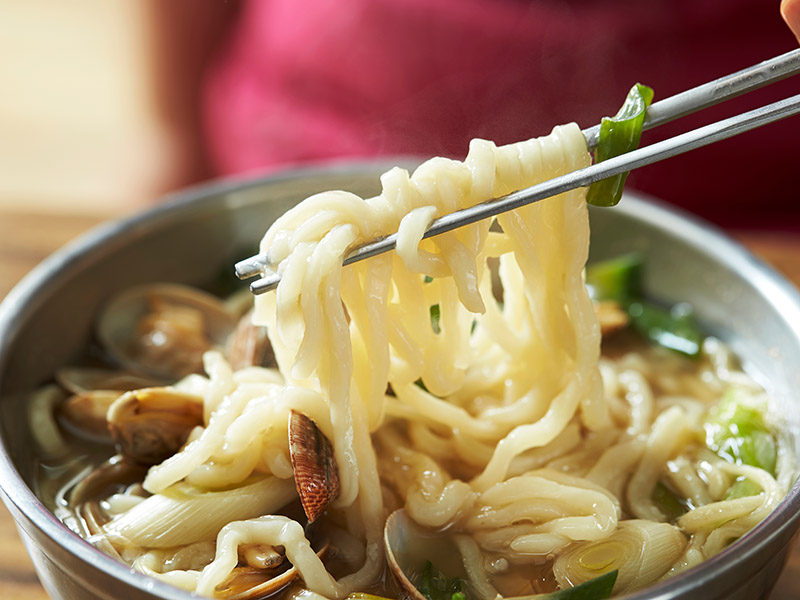
Kal-guksu, also known as knife-cut noodle soup, is a Korean specialty dish that is delicious and labor-intensive at the same time. The original recipe for the knife-cut noodle soup dates back to the Joseon dynasty – around the late 1600s.
The dough to make the Kal-guksu noodles are made by combining wheat flour and eggs. If you are familiar with ramen noodle-making, you would see a big difference: the baking soda is missing (it’s what makes the noodles glossy). A suitable substitution is ground bean powder.
The broth for this noodle soup is rich and flavorful, though with only a few ingredients. The main elements of the soup are kelp, dried anchovies, and some type of shellfish. The instructions also said to simmer the broth for a long time to draw out all its flavors.
Kalguksu is so good that it is even recommended on Netflix.
11. Dak-Galbi – 닭갈비 (Korean Spicy Chicken Stir-fry)
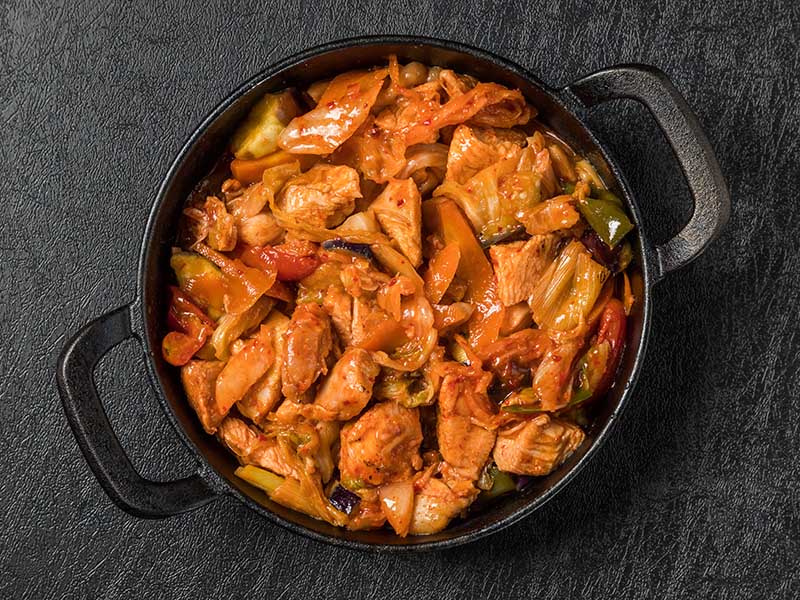
The term “dak” translates to chicken, whereas the term “galbi” means ribs. But Dak-galbi does not mean chicken ribs by any sense. This dish comes together by stir-frying marinated diced chicken in a gochujang-based sauce.
Though accompanying ingredients may vary, the most common components of Dak-Galbi are marinated chicken, cabbage, sweet potatoes, and tteok (Korean rice cakes). The Dak-galbi dish is usually served with perilla leaves and lettuce as a wrapper.
A little fun fact about Dak-galbi is most popular in the districts where the meat industry was thriving. This made the cost to make Dak-galbi relatively low, earning the dish its nickname “people’s Galbi.”
12. Mandu – 만두 (Korean Dumplings)
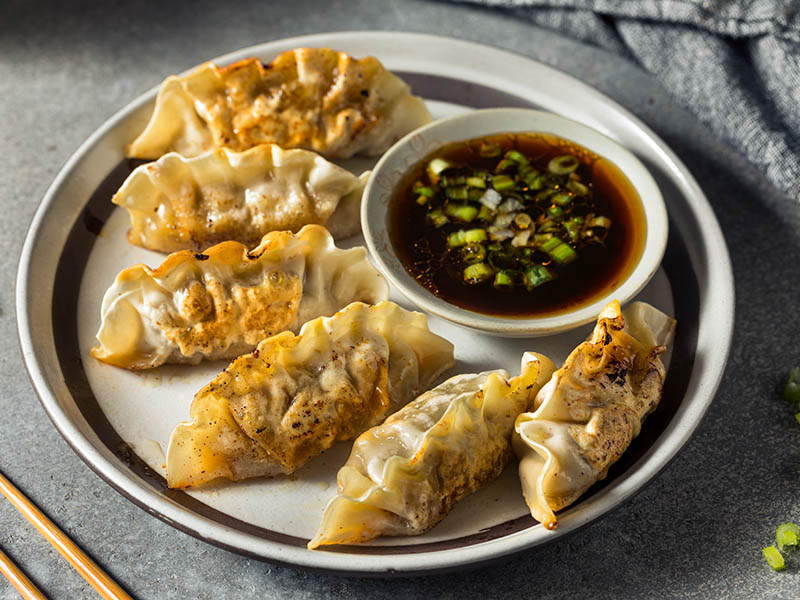
In the 14th century, the Yuan Mongols brought to Korea their practice of making Mandu. This was the time when the Goryeo dynasty reigned, and meat consumption was frowned upon because of Buddhism. Mandu was the first of many reintroductions of meat into the Korean diet.
The dough is only made from flour and water, kneaded until enough gluten has developed to turn the dough smooth and elastic. The filling usually involves some type of minced meat mixed with vegetables.
Think of mandu as a blank canvas, a concept on which you can apply whatever works for you. Not only can you have your filling of choice, but you can also have your cooking method of choice. Try boiling, pan-fried, steam, and many more options to see what you like.
Eating Mandu is an experience that you must try in Korea.
13. Bulgogi – 불고기 (Korean Style BBQ)
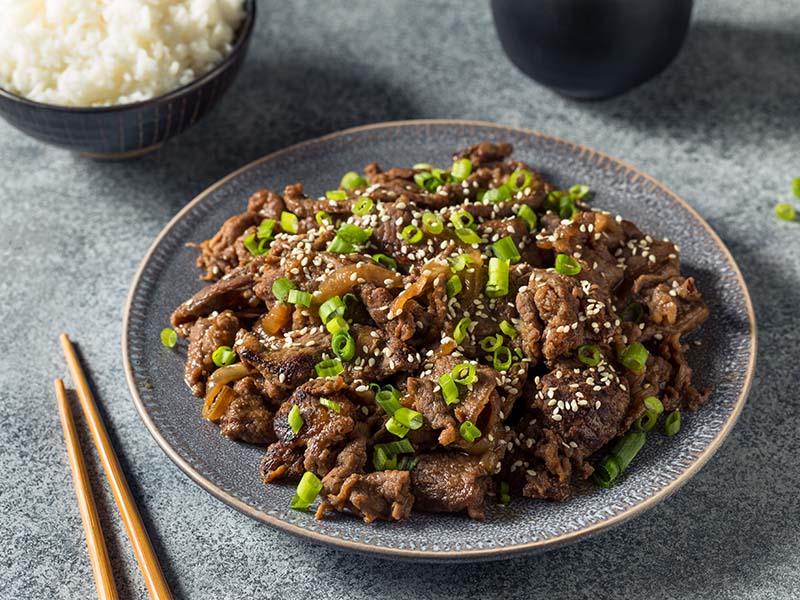
Bulgogi is another well-known gem in the repertoire of fantastic Korean foods. The term simply means “fire meat.” This is a type of grilled meat that is popular among Koreans and foreigners alike. Don’t confuse Gogigui with Bulgogi because they are not the same.
This dish is made by marinating thinly sliced meat such as beef and pork cooked on high heat. Usually, the grill or stove-top griddle works best to prepare bulgogi. But the star of the show comes from the marinade, which you can make from scratch or buy at the store.
Bulgogi is traditionally made with beef sirloin; however, modern variations have also included cuts of pork. A distinctive flavor that is often associated with Korean Bulgogi is that it is a bit sweeter than other frilled meat due to the syrup that is in the marinade.
Wander The Streets Of Korea With These 13 Korean Street Food
Have you ever wondered what the Korean street food culture is like? I am pleased to inform you that what I am about to show you below is only a corner in the vast picture that makes up the way Korean people rock out street food.
14. Dakkochi – 닭꼬치 (Grilled Chicken Skewers)
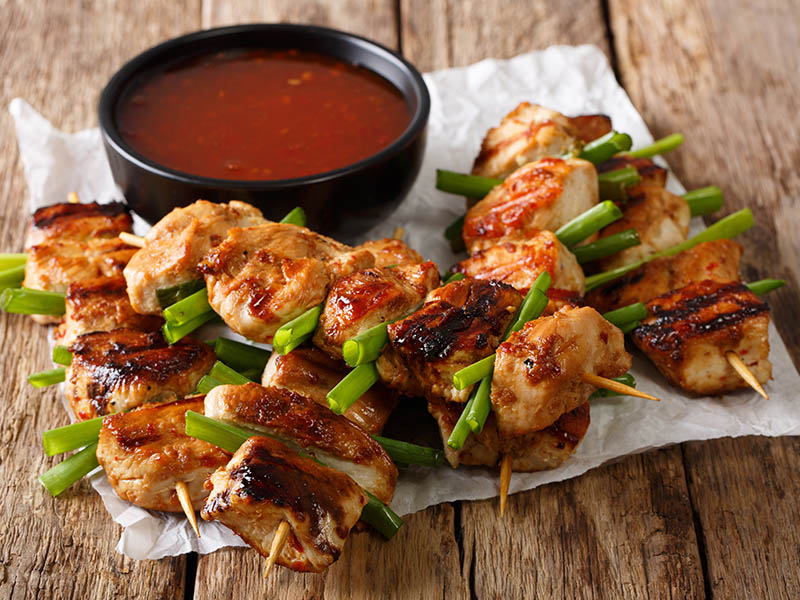
Dakkochi is a type of grilled skewer that is made of chicken and scallions. The chicken is prepared by dicing up the breast into smaller pieces and marinating them in a mixture of gochujang, sesame oil, sugar, and garlic.
The cook arranges the chicken onto bamboo skewers alternately with Korean scallions and grills them over a bed of charcoal. The charcoal is what gives the chicken its distinctive smokiness. The chicken is also brushed regularly with the marinating sauce to keep it shiny.
15. Hoeori Gamja – 회오리 감자 (Tornado Potatoes)
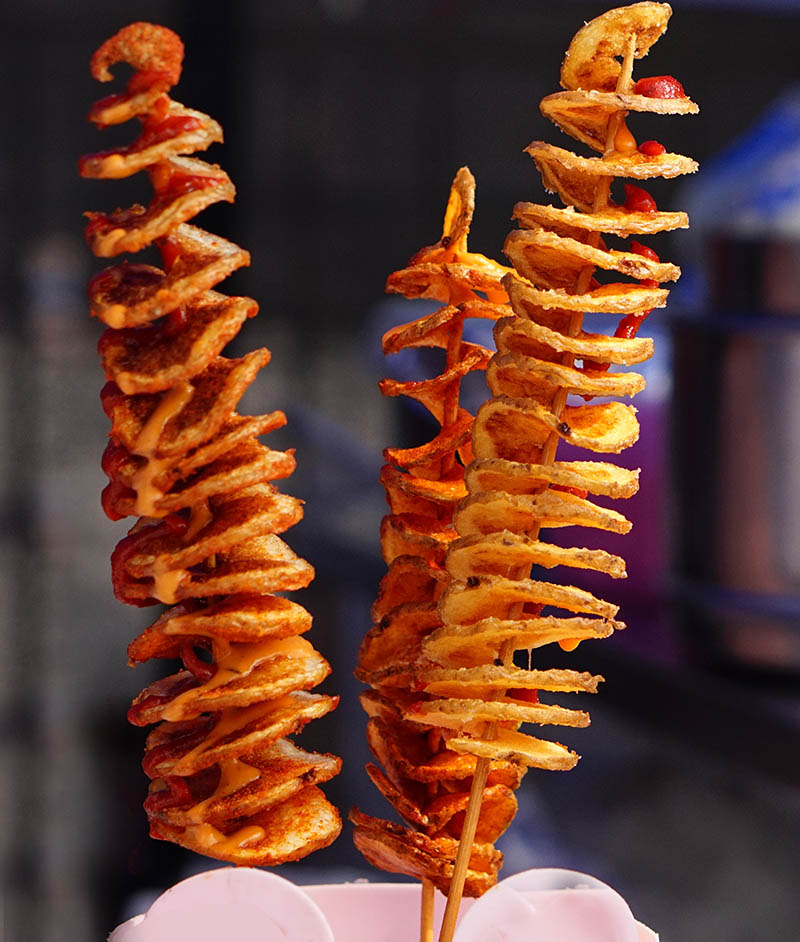
This is a newer addition to the Korean street food crowd but still just as impressive and tasty. The name should give you an idea of what this particular snack may look like. Yes, it does spiral like a tornado, and yes, which is how it acquires its name.
A tornado potato is a whole potato cut to resemble a spiral that is then displayed on a wooden skewer. This snack is usually seasoned with salt, onion, honey, or cheese. My favorite way to enjoy this dish is to eat one spiral at a time.
16. Hotteok – 호떡 (Sweet Korean Pancake)
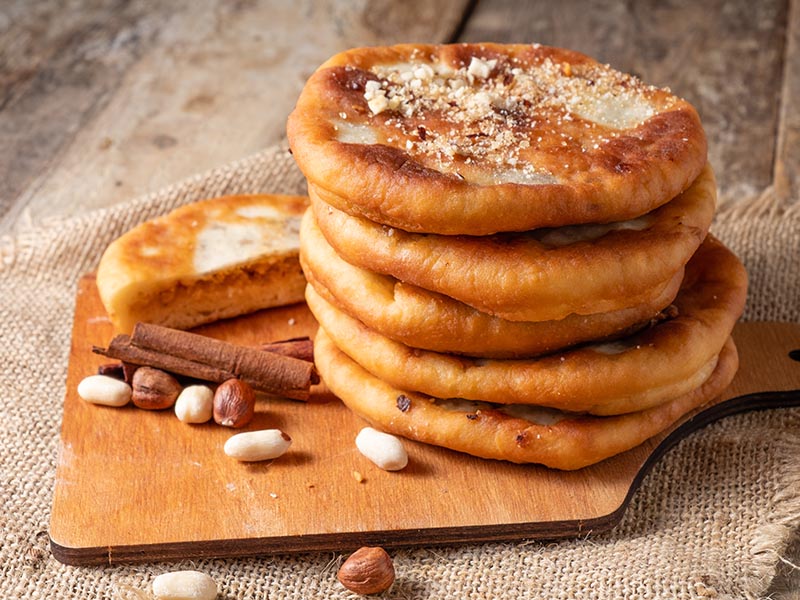
It is a common belief that Hotteok came to be a part of Korean cuisine via the cultural exchange brought over by Chinese merchants. Its original name was Tang Bing before it was adapted into the Korean language.
Hotteok is not based on Korean rice cakes (Tteok) as the name may lead you to believe. It is a type of stuffed pancake that is surprisingly sweet on the inside. The main ingredients in the dough are wheat flour, sugar, yeast, water, and milk, making it quite rich on the palette.
The filling is traditionally made with a combination of nuts, sugar, cinnamon, and honey. In Korea, people enjoy Hotteok during the wintertime due to the large quantity of sugar that is in the filling and the dough.
Hotteok is one of Korea’s favorite winter snacks.
17. Pajeon – 파전 (Korean Scallion Pancakes)
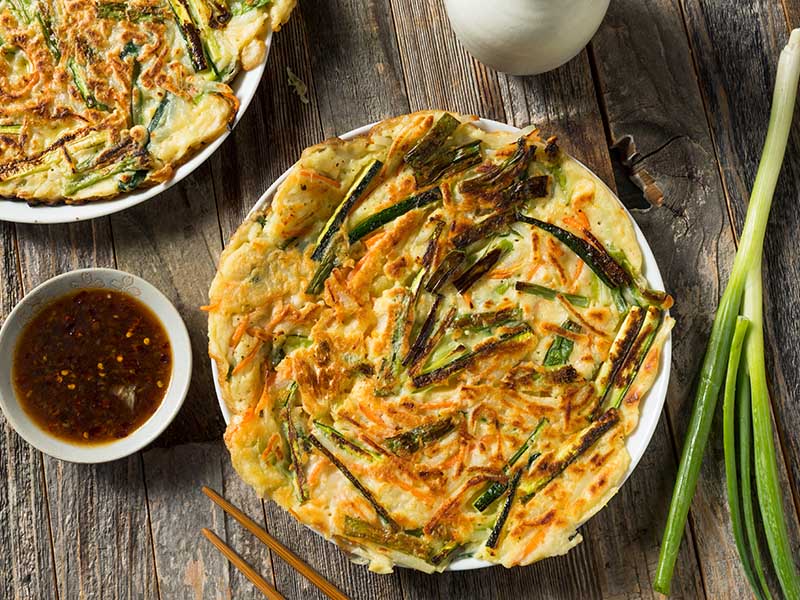
Pajeon is only one of many delicious pancake varieties from Korea that you will never have enough of. Or maybe it’s just me. But it seriously is so addictive despite using a short list of ingredients and a minimal-effort cooking method.
The batter is non-yeasted, unlike the scallion pancake dough that you may find in Chinese recipes. The texture of the batter is looser than Western-style pancakes and is made with flour, soybean paste, sugar, and water. Pajeon is then fried until golden brown with scallions.
Three varieties of Pajeon are widely popular. The one with plain scallions I just told you about and the seafood version called Haemul Pajeon are some of them. The last variant is Dongnae Pajeon, which honors the people of Dongnae’s late 16th-century victory against Japanese invaders.
18. Soondae – 순대 (Blood Sausages)
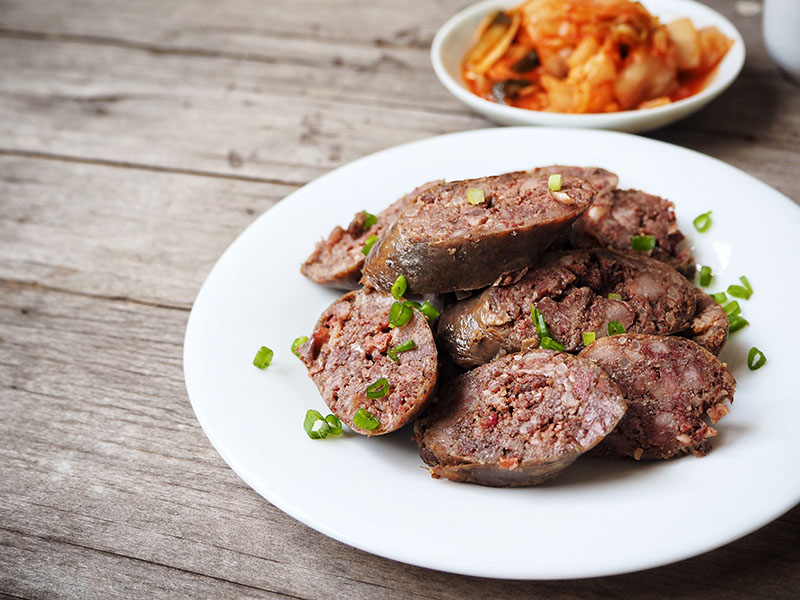
Similar to the English black pudding, Soondae is a type of blood sausage made by stuffing the pig’s intestine with minced meat, rice, various spices and, you guessed it, blood. This specialty has a characteristic blackish-brown color.
Though the traditional recipe calls for the Soondae to be stuffed with rice, modern variations substitute it with glass noodles. Perilla leaves are sometimes a part of the ingredients to give the Soondae more flavor.
This method of utilizing pig’s blood and intestine is not only well known in Korea but there is also a version of it in the UK and many other Asian countries. But the Koreans do it best if you’re asking me.
This is your introduction to Korea’s favorite blood sausages – Soondae.
19. Bindae-tteok – 빈대떡 (Mung Bean Pancakes)
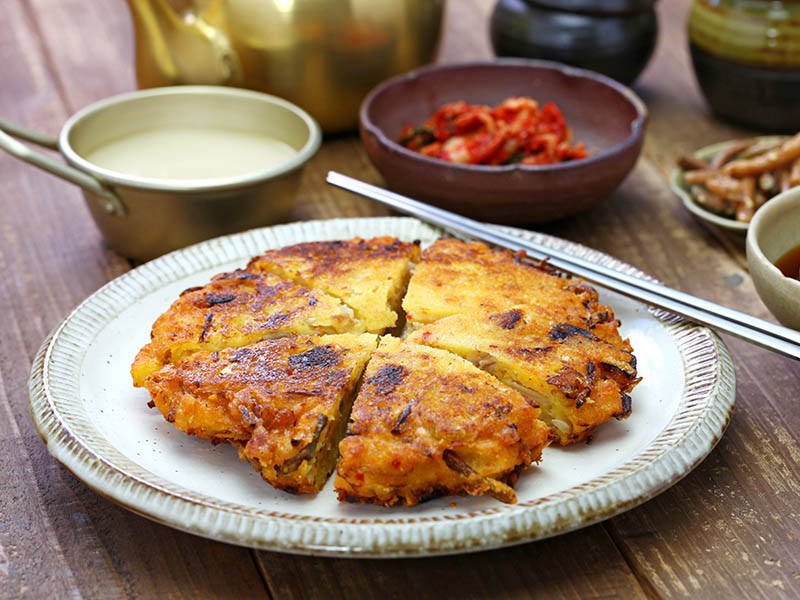
Bindaetteok is a popular street food in Korea that features mung beans as its main component. The bean batter fries well with pork, bean sprouts, and bracken (a type of edible fern). Bindae-tteok creates such a harmonious blend of texture.
Traditionally, Bindae-tteok is a more luxurious food item using leaner meat. It is usually sold in Korean sky markets as finger food to be eaten on the go. When less well-off people make Bindae-tteok, they can only use poorer quality meat with higher fat content.
The fat made these bean pancakes that much more enjoyable and flavorful.
20. Gimbap – 김밥 (Korean Rice Rolls)
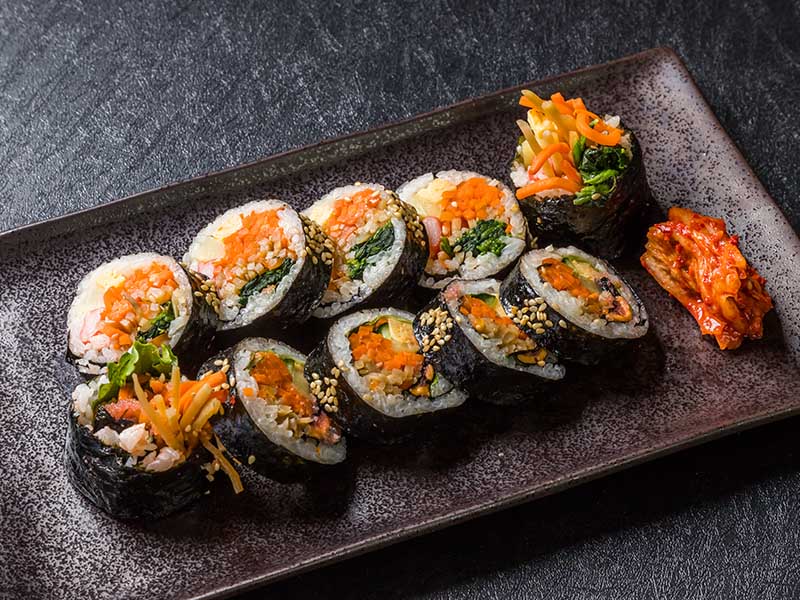
Gimbap, or Kimbap, is not only famous in Korea but it is famous everywhere. This is a Korean version of a sushi roll. White rice, assorted vegetables, fried eggs, and seafood are rolled into a tube in the “gim” (thin sheets of dried seaweed).
There are debates amongst historians as to whether Gimbap originated from the integration of Japanese food, like sushi, into Korean cuisine. Other sources propose that this dish is an evolution from the Korean’s method of wrapping rice and side dishes in seaweed to eat.
You may be able to find these delicious treats not only in the streets of Korea but also at your local grocery store, in the deli section. It is light and healthy, perfect for when you need a quick and delicious office lunch.
Who knows there are so many types of Gimbap!
21. Twigim – 야채튀김 (Korean Tempura)
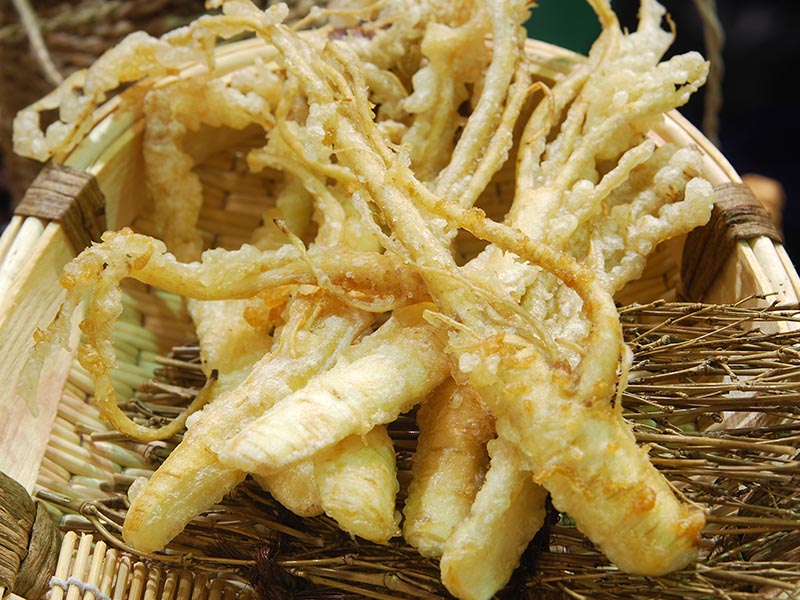
Think of the Korean Twigim the same way you would think of the Japanese tempura. They are the Korean take on deep-fried vegetables in a crispy and light batter. There is a specifically made Twigim batter mix that you can buy in Korean stores.
The term “Twigim”, though mostly associated with fried veggie sticks, refers to the method with which these vegetables are prepared. The Korean name directly translates to “fried food.” You can enjoy Twigim on its own or in addition to Tteokbokki like they do in Korea.
You can enjoy Twigim as light street food in open sky markets or as a side dish at the Korean dinner table. You can pick and choose whatever vegetable you want to fry. The most common varieties are zucchini, carrots, and sweet potatoes.
22. Odeng Soup – 오뎅국 (Fish Cake Soup)

I mentioned Eomuk in the section about Tteokbokki as a type of Korean fish cake. It turns out that another name for this tasty treat is Odeng. This delicacy can even be eaten independently from Tteokbokki as a type of street food.
Odeng soup is the perfect comfort food for a harsh winter day, especially if you are feeling a bit unwell. This soup is super easy to eat and not to mention easy to make. All you need is some Odeng, kelp, and dried anchovies.
You can usually see this soup served as a side dish to some heavier main course. The flavor of the Odeng soup is full of umami and savory goodness. The soft and chewy texture of the Odeng itself is very complimentary to the broth.
Learn more about Odeng from an experienced traveler.
23. Hodu-Gwaja – 호두과자 (Walnut Pastries)
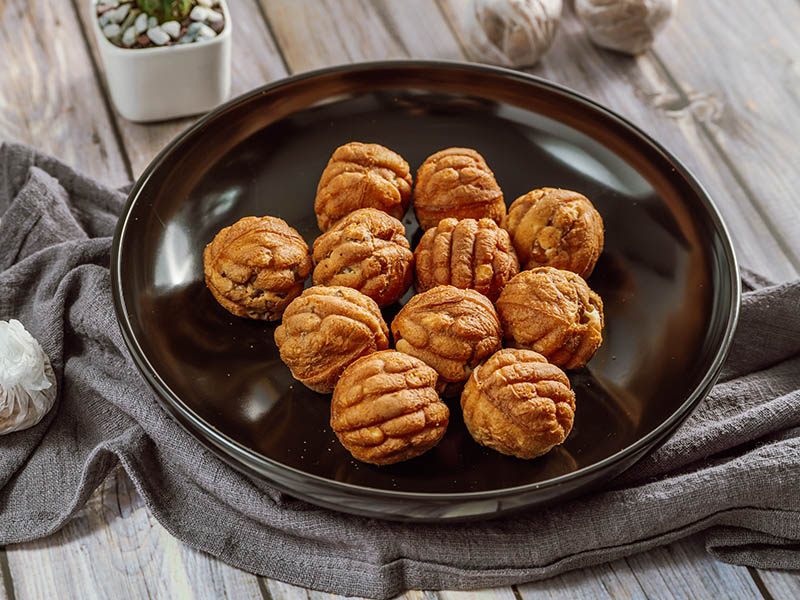
Hodu-gwaja is a type of baked walnut goodie that has been a crucial part of many Koreans’ childhood. This delicious treat is shaped like a walnut and is made from a combination of pounded walnut and wheat flour.
Usually, the batter is mildly sweet. Most of the sweetness of this baked confection comes from the sweetened red bean paste that fills the inside of the Hodu-gwaja. It is golden brown in color and has a fluffy and light texture that is hard to compete with.
Though it is commonly called walnut cookies, the texture of the Hodu-Gwaja more closely resembles a vanilla cake. You can only make this treat at home if you invest in a pan that is specifically made to shape these cookies.
24. Bingsu – 빙수 (Korean Shaved Ice)
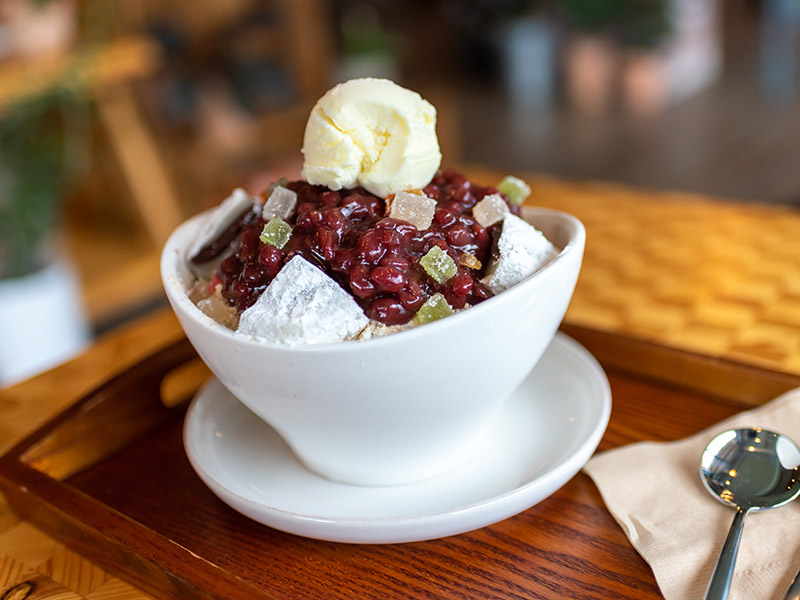
Let’s take a much-needed break from the list of savory food and enjoy this cool and mildly sweet cup of Korean shaved ice dessert, also known as Bingsu. You’ve had shaved ice before like this one as a tasty summer treat to cool off from the heat.
The term Bingsu is applicable to the dessert that is shaved ice topped with sweet toppings. Only the variant with the sweetened red bean is called Patbingsu, which happens to be the most popular variant in Korea,
Koreans sure know how to elevate that simple snack with some condensed milk and sweetened red beans. I seriously have dreams about some sweet Patbingsuwhenever summer comes around.
25. Beondegi – 번데기 (Boiled Silkworms)
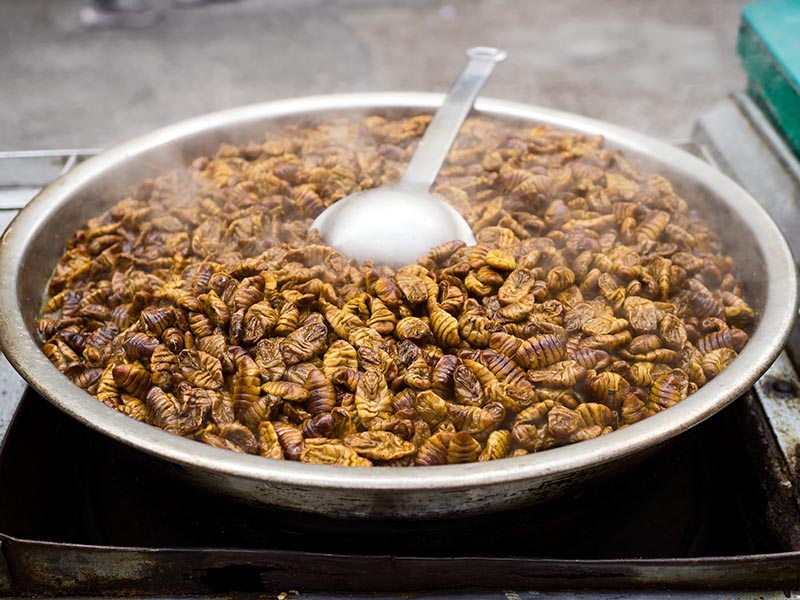
Another obscure but not at all unpopular street food that you may find on the streets of South Korea is this steamed or boiled Beondegi. This name refers to (I hope you are not squeamish) the pupae of the silkworms.
Uncommon as they are in the states, this delicacy is quite popular in many Southeast Asian countries. They are seriously delicious once you get used to the texture and flavor. They are quite rich in taste and will pop readily in your mouth.
Beondegi may look a bit intimidating, but it is incredibly high in protein and is, in fact, so popular that you can even find the canned version of this food in some Korean supermarkets and convenience stores. If you are not a fan of the salty flavors, the sweeter candied variety is available.
Beondegi is only one of many obscure street foods in Korea.
Korean Trendy Foods That Have Taken The Internet By Storm
Just because these Korean food names have been all the rage on the Internet recently doesn’t mean they don’t have a long history. It is fun to learn about them.
26. Tteokbokki – 떡볶이 (Hot And Spicy Rice Cakes)
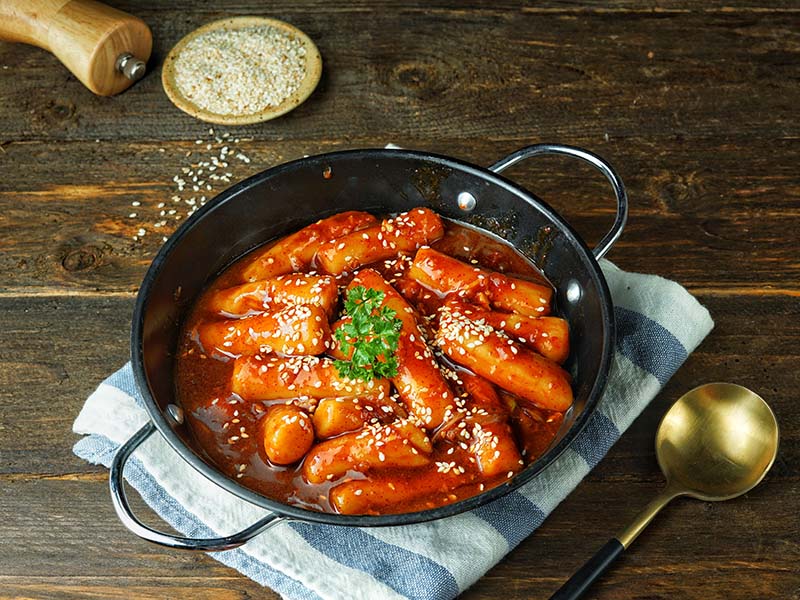
Another name or rather a translation of the name Tteokbokki is “simmered rice cakes”. And just like many other Korean dishes, Tteokbokki got its name from the way it is cooked. Tteoks are the chewy cylindrical rice cakes that you find in Tteokbokki.
Typically, Tteokbokki is made by simmering Tteok with some onions, garlic, gochujang, and Eomuk (Korean fish cakes). It is mildly sweet, savory, and pleasantly spicy. Though if you are new at this, I’d recommend the least spicy option.
As a novice to the world of Tteokbokki, there is a less popular option that you can try out. Gungjung-Tteokbokki is like traditional Tteokbokki though the gochujang is replaced with soy sauce. This makes the Tteokbokki brown instead of bright red.
27. Bungeo-ppang – 붕어빵 (Korean Fish Shaped Pastry)

Bungeo-ppang is not a type of food that you eat when you perform bungee jumps, let me tell you that much. I was pleasantly surprised when I found out that Bungeo-ppang is a type of fluffy cake that is shaped like a fish.
The origin of this name came from the word “bungeo” for carp and “ppang” for bread. The origin of this treat was from the introduction of Japanese baked sea bream in the early 20th century. The pastry regained its popularity in the 1990s.
The traditional filling of the Bungeo-ppang calls for sweet red bean paste, as it is the most common sweet filling in the past. But nowadays, this dessert is filled with all sorts of sweet creams such as pastry cream, chocolate cream, and so on.
These carp-shaped pastries are a delicacy in Korea.
28. Kimchi-ppang – 김치빵 (Korean Kimchi Pork Buns)
This is another great application of the beloved Lacto-fermented cabbage. When you combine Kimchi with flavorful, tender pork bits, and fluffy soft buns on the outside, you will create an irresistible comfort food. I can’t think of a greater combo than the flavors of Kimchi-Ppang.
In the old days of Korean street foods, Kimchi-ppangs were usually steamed until the buns were done all the way through. Nowadays, you can make this recipe with the help of your kitchen ovens, and it will come out just as delicious.
Though these Kimchi pork buns are jumbo enough to be a meal on their own, it is available as a type of popular street food in many places around the country. The next time you find yourself hungry in South Korea, make sure to locate the closest vendor that sells these Kimchi-ppang.
29. Jjinppang – 찐빵 (Korean Steamed Buns)
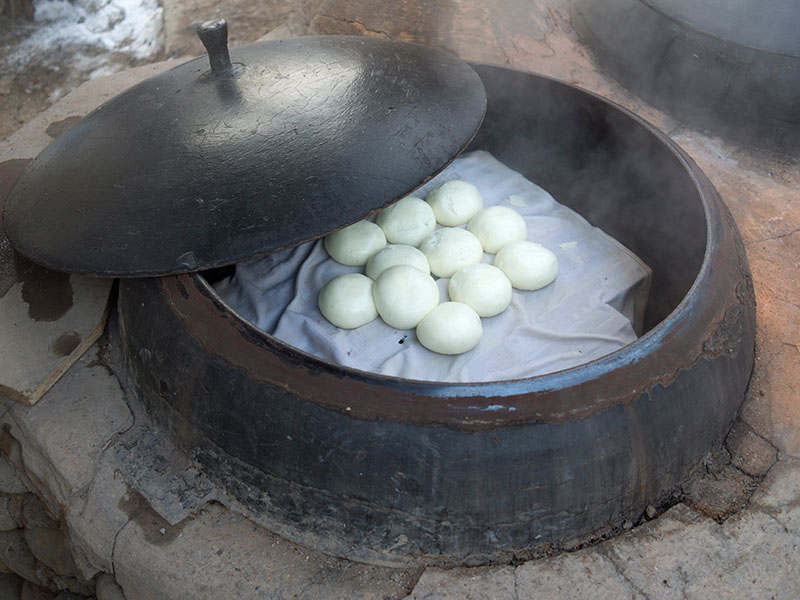
Jjinppang is the Korean version of steamed buns. It is so famous that there is a town named Anheung that bears the title “steamed bun village” in the Gangwon province. Here, various local shops produce the renowned Anheung-Jjinppang variety.
The traditional filling of the steamed Jjinppang is red bean paste combined with broken pieces of beans and husk. The dough leavens with the help of makgeolli yeast (a byproduct of Koren rice wine production).
Newer versions of Jjinppang may choose to exclude the yeast from the sourdough. There is also an version of Jjinppang that contains Gamgyul, a delicious fruit found in Korea. This version is called Gamgyul-Jjinppang (mandarin orange steamed buns) and has a distinctive orange color.
Take a tour of the “steamed bun village” where Jjinppang is made.
30. Gyeran-ppang – 계란빵 (Korean Egg Bread)

All your hopes to lose weight are null and void when this egg-shaped pastry tempts you. Vendors make Gyeran-ppang in a machine with a vanilla egg batter and a whole egg cracked into the middle. Korean Egg Bread is a decadent breakfast food and a delicious snack.
The recipe for this dessert is very egg-heavy, which makes it very rich. You can enjoy this street food just by itself or with other common toppings such as diced ham, cheese, and parsley. Gyeran-ppang originated in the port city of Incheon before conquering the rest of the country.
31. Kkwabaegi – 꽈배기 (Twisted Donuts)
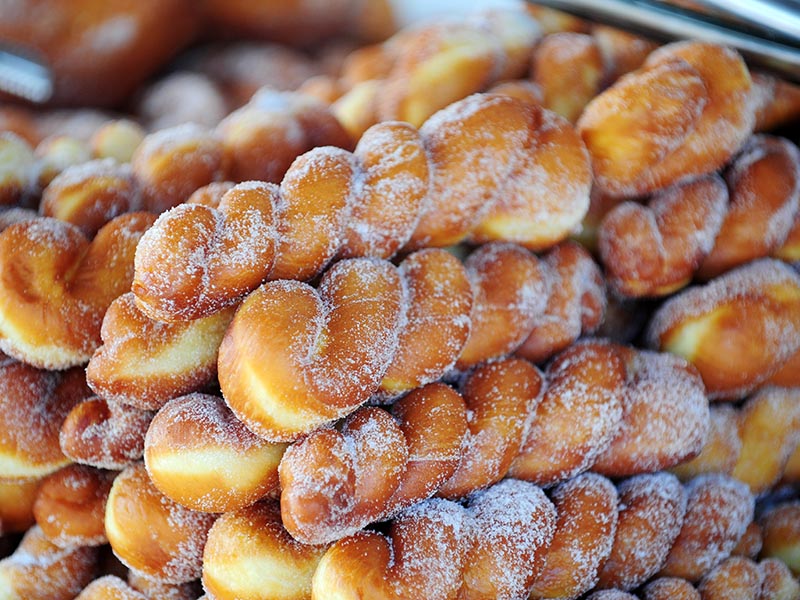
You can find desserts looking like this one in most cultures around the world. Also known as the twisted donut, Kkwabaegi is a type of Korean fried pastry. You can find the Mahua in China, Churros in Mexico, and Kkwabaegi in Korea.
You might be pleasantly surprised that twisted rope shape-shaped donuts actually existed long before the round ones. Though the round shape of the Western donuts was not influenced by the Korean Kkwabaegi, it still stands to show the long history of Kkwabaegi.
Essentially, you prepare this snack by frying a chewy yeasted dough in oil until it is nice and golden brown in color but light and fluffy on the inside. Then you roll the fried Kkwabaegi in a mixture of sugar and cinnamon. Doesn’t that sound so heavenly?
32. Dalgona Candy – 달고나 (Sugar Candy)

Though the Dalgona candy has been a traditional treat in South Korea for a long time, it has found recent fame through social media and Korean TV shows. This sugar candy has the texture and color of a honeycomb. It is brittle and melts in your mouth in the best way.
Dalgona candy is made by caramelizing sugar until it is golden brown and adding baking soda to the mixture. The caramelized sugar will turn acidic, which then reacts to the baking soda to become foamy, light, and brittle.
When the melted sugar is still hot, the candymaker will pour it on a cold surface and flatten it out with a circular press. When it has cooled down but hasn’t solidified, sellers will stamp a shape onto the candy.
There is a tricky game with this type of candy, in which the player tries to break the candy around the shape without ruining the whole thing.
Dalgona candy has been the Internet’s most talked-about candy after viral fame.
33. Gamja Hot Dog – 감자핫도그 (Korean Corn Dogs)
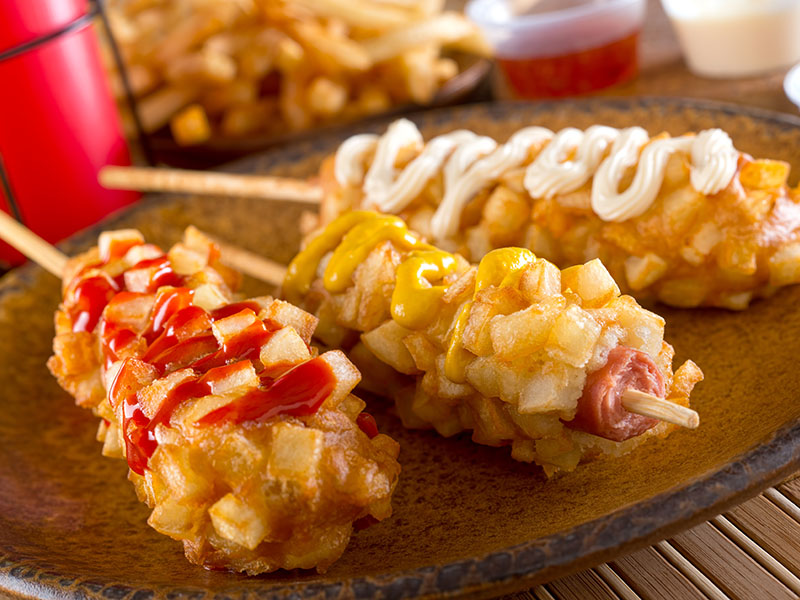
This isn’t your regular corn dog. This Korean version is fragrant, crunchy, and salty in all the right places. Not to mention the way it looks just makes you want to pull out your phone and snap a picture.
The main difference between an American corn dog and a Korean corndog is the batter. Where the American version uses corn flour to make a batter (hence, corn dogs), the Korean corn dog is dipped in yeasted batter and covered in cubed cheese and bread crumbs.
When you bite into the Gamja hotdog, you will get an explosion of familiar flavors put together in the best ways. The sausages are salty and savory, the cheese is tangy, and the batter is light and crispy. It cannot get better than this.
34. Gilgeori Toast – 길거리 토스트 (Korean Egg Toast)
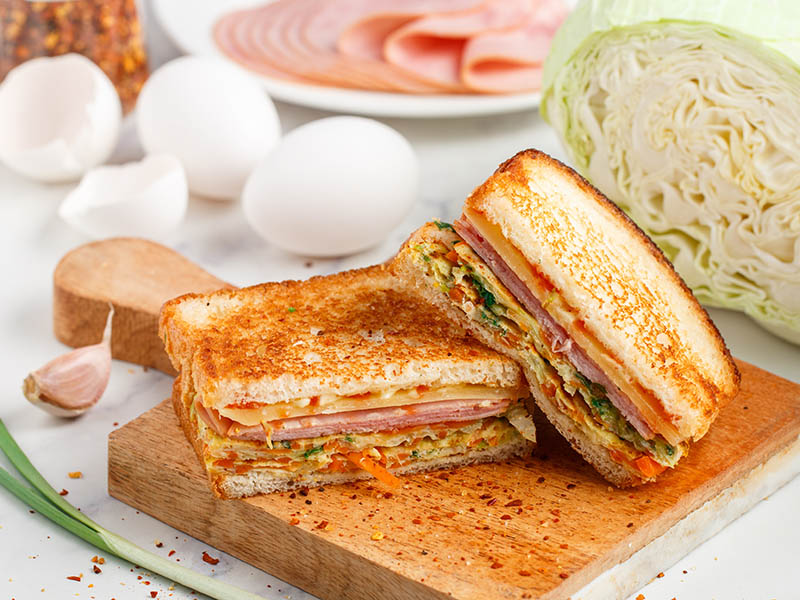
The name of this sandwich directly translates to “street sandwich.” Gilgeori toast is crispy and buttery on the outside and filled with a delicious egg and sauteed cabbages mixture in the middle. This flavor combo is so good that its recipe has been featured in numerous publications.
Many people have been in love with this healthy, aesthetically-pleasing sandwich for a long time. Not only is it tasty, but it is also beautiful to look at with the golden yellow of the toasted bread, green cabbages, and red ketchup. The flavors and texture are also well-balanced.
In addition to being healthy and filling, Gilgeori toast comes together very quickly with vegetables that can sit in the fridge for a long time. So I do recommend you stock up on some crunchy veggie and make this toast instead of an omelet for your next breakfast.
35. Naengmyeon – 냉면 (Cold Noodle Soup)
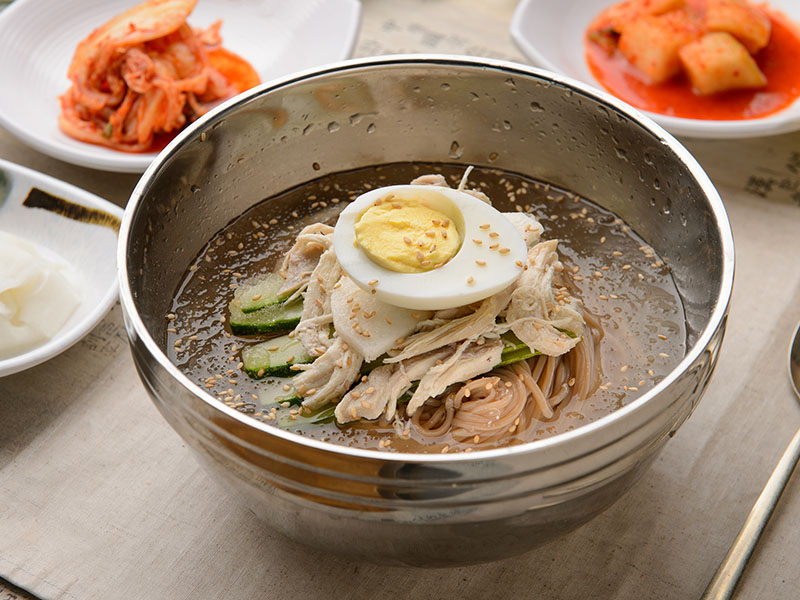
Unlike most of the Korean food on my list, Naengmyon originated in the regions of North Korea. Naengmyeon is another dish that gained widespread popularity with the help of some hit TV shows, though records reflect that Naengmyeon has been around since the 19th century.
Naengmyeon is a type of cold noodle that is served in anchovy and kelp soup. The flavor is super refreshing to the body when eaten on a hot summer day. The preferred garnish of Naengmyeon is fresh cucumbers and sesame seeds. You can even make this at home!
The noodle of Naengmyeon contains a combination of various starches such as buckwheat, potatoes, sweet potatoes, and arrowroot (this gives the noodle its signature grayish color.
Naengmyeon has a long and exciting history, which you can learn here.
36. Jokbal – 족발 (Pig Trotter Dish)
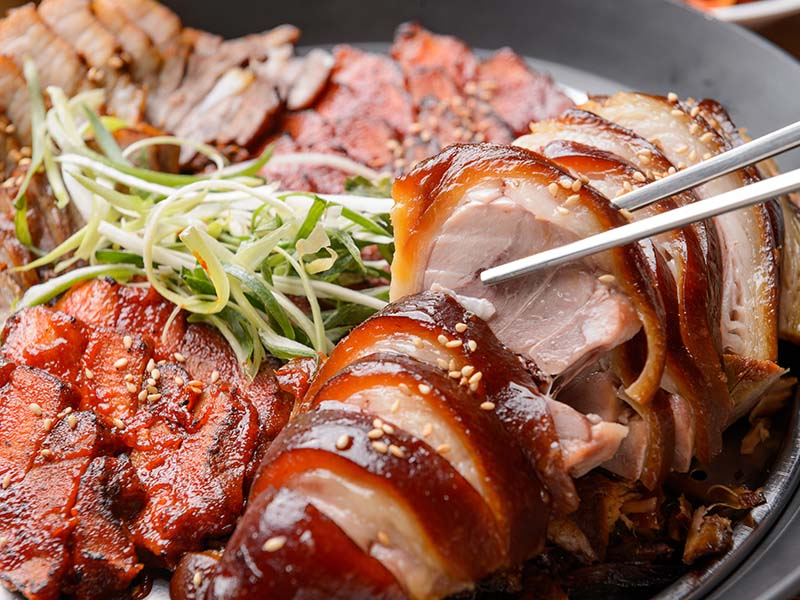
Jokbal is cooked in a low and slow method, much like the slow-roasted Bosam. But instead of using the pork shoulder wrapped in twine, Jokbal calls for the pig trotters. Pig trotters have higher fat content and are more collagenous. That is why this dish is much greasier.
People enjoy Jokbal with various side dishes and fresh vegetables to be eaten as ssam (wraps). The dish is usually served as festival food since the preparation process is quite labor-intensive.
Because Jokbal is a food that is high in collagen, many Koreans believe this to be a beauty-enhancing food. They also say that Jokbal can counteract the alcohol you drink when eating it, making it less likely for you to have a hangover.
37. Chimaek – 치맥 (Chicken And Beer)
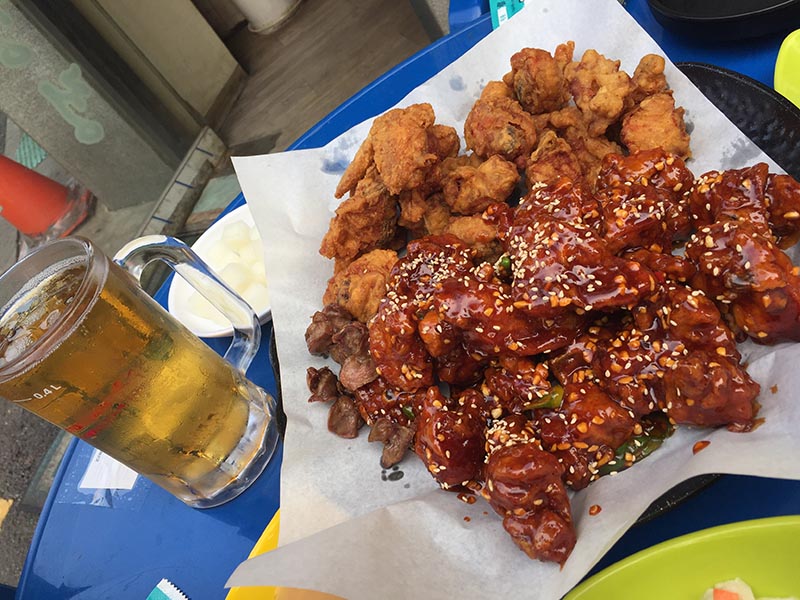
This is a wordplay on the word chikin which means “fried chicken,” and the word maekju, which translates to “beer.” Chimaek is a match made in heaven that has proven to be quite popular amongst the Korean demographics.
There are rumors that the recipes surrounding this dish have been around in Korean culinary history for a few hundred years. But Korean drama shows have made Chimaek more internationally known and loved.
With Chimaek being featured on Korean television, the rising fame of this food has increased phenomenally. This is so much so that people are willing to wait a few hours to get their hands on some Korean brand Chimaek.
See how the cast of the Kingsman movies responds to this Chimaek combo.
38. Jjambbong – 짬뽕 (Spicy Seafood Noodle)
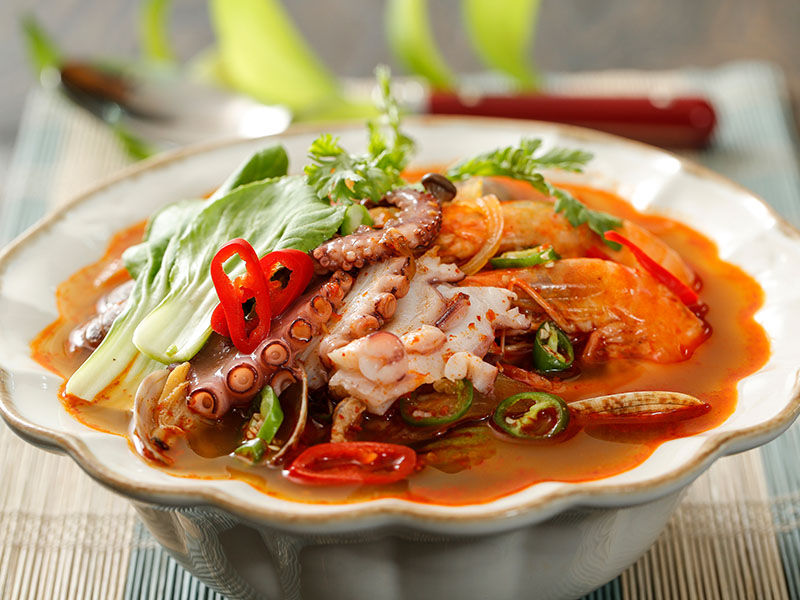
This is a creation that stemmed from the integration of Chinese – Korean cuisine into Korean society. It is a hot and spicy noodle dish that is packed with seafood and just the right amount of heat to make you sweat.
Jjambbong has become so beloved that companies in Korea have created an instant ramen version that you can buy at your local Korean grocery store. Though in my opinion, the ones you make from scratch are still the best.
It is very popular in Chinese restaurants all across South Korea. All my Korean friends like to eat this noodle soup dish when they are feeling under the weather and need something to clear up their sinuses. Give it a try the next time you see it on the menu.
The Art Of Korean Side Dishes (Banchan)
The amount of work that goes into creating Korea’s most famous element is truly astonishing. Banchan (반찬) is a blanket term for the many side dishes that one eats with cooked white rice in Hansik (traditional Korean food).
39. Chamchi-Jeon – 참치전 (Tuna Pancake)
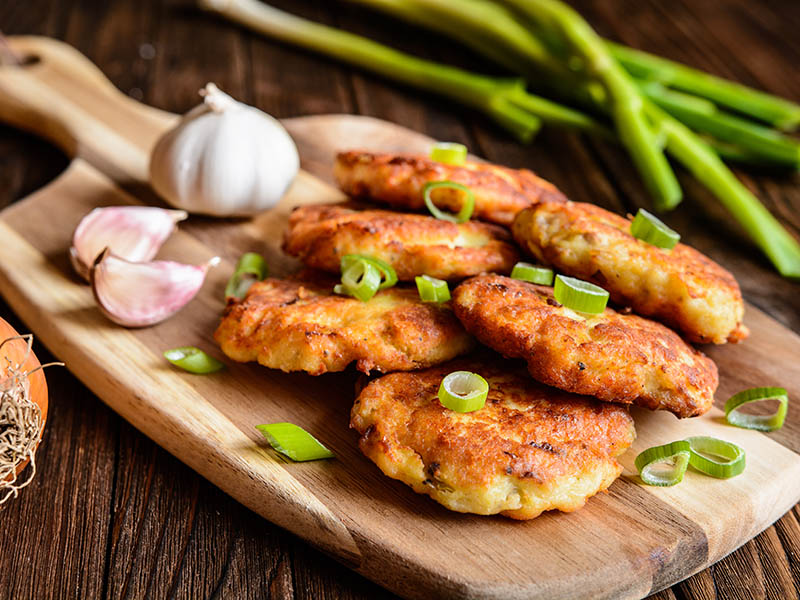
You may have a can of packaged tuna sitting somewhere in your pantry. If you don’t know what to do with it, try your hands at making Chamchi-jeon. With just a couple of steps and a few simple ingredients, you can enjoy some delicious tuna fritters.
This is a common Korean side dish that is made from canned tuna, diced vegetables, garlic, and a bit of flour. Chamchijeon comes together incredibly quickly. This is helpful for when you need to have a side dish but don’t want to spend a week fermenting something.
Because of its savory and mildly greasy taste, it pairs extremely well with many other Lacto-fermented side dishes, such as Kimchi. Together, they truly elevate the dining experience that comes with Korean food.
40. Hobakjeon – 호박전 (Pan-fried Zucchini)

You will find wide varieties of Jeon (fried food) as you navigate your way through Korean cooking. Hobakjeon is a side dish that involves battered and fried zucchini pieces like a pancake.
Zucchini has made its way into one of Korea’s favorite vegetables. It grows exceptionally well and is ready for harvest throughout the summer and the fall. Some traditional medicine experts describe this squash as cooling for the summer.
This dish is elegantly simple and is a testament to the ability to bring flavors out of the most simple ingredients in Korean cooking. It is healthy and packed full of flavors. Since Hobak-jeon is a side dish, you can eat it with rice, Kimchi, and other side dishes.
Hobak-jeon is the only one in the wide world of Korean Jeon (fried food).
41. Hobak Namul – 마른 호박나물 (Korean Zucchini Salad)
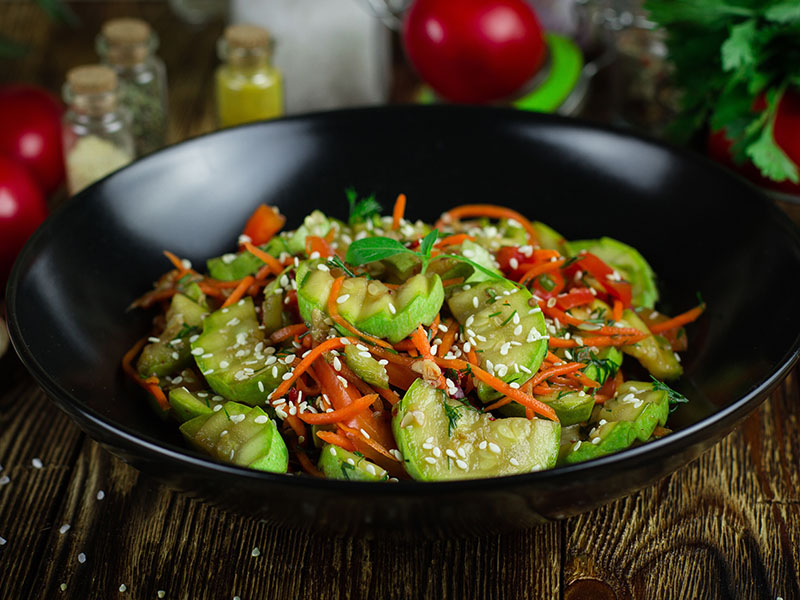
Another great way to enjoy your summer squash and zucchini is by making some Hobak Namul. This Korean cooking idea is so easy that it will be your next palatable side dish for juicy steak as it has been in Korean food culture for a long time.
Fresh Korean Zucchini is harvested and stir-fried in a mixture of chilies, garlic, sesame oil, and fish sauce. The fish sauce really brings some umami flavor to the mildly floral aroma of the squash.
Hobak Namul will also make an excellent topping for your bibimbap. This dish is good for you in the summertime, especially for those who are venturing into the vegan lifestyle. Simply omit the fish sauce, and the dish is surely vegan-certified.
42. Sigeumchi-namul – 시금치나물 (Spinach Side Dish)
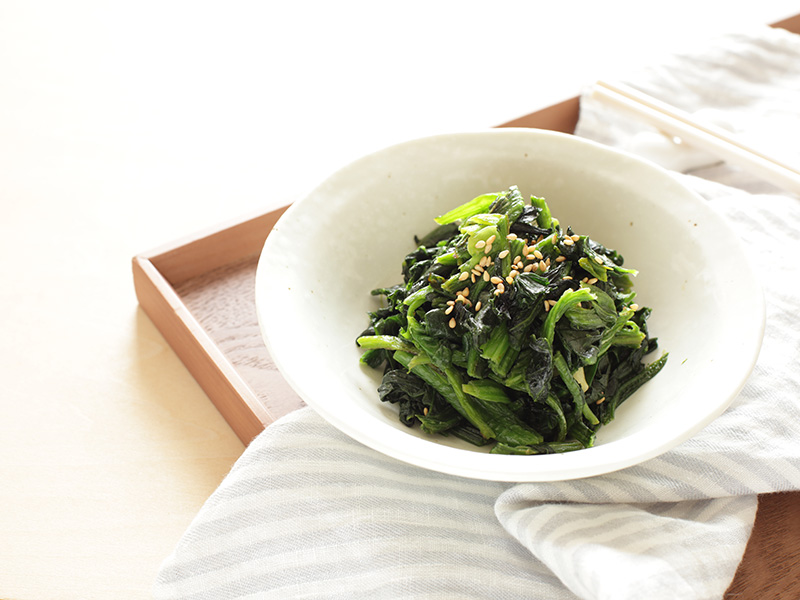
What is there not to love about the newest superfood – spinach. Though more recent findings have proven that spinach is dense in nutrients such as iron, vitamin A and vitamin E, Koreans have been using this delicious green as a side dish for a long time.
Sigeumchi-namul only requires minimal cooking effort. Simply blanch the greens until they are tender, squeeze out all the juice, and toss them in some seasoning. While this dish is vegetarian-friendly, it is incredibly delicious when paired with grilled meat or white rice.
You will often encounter Sigeumchi-namul in restaurants that offer Korean BBQ. It is slightly savory and very herbaceous, which makes it a good accompaniment for rich and oily food.
43. Kimchi – 김치 (Fermented Cabbage)
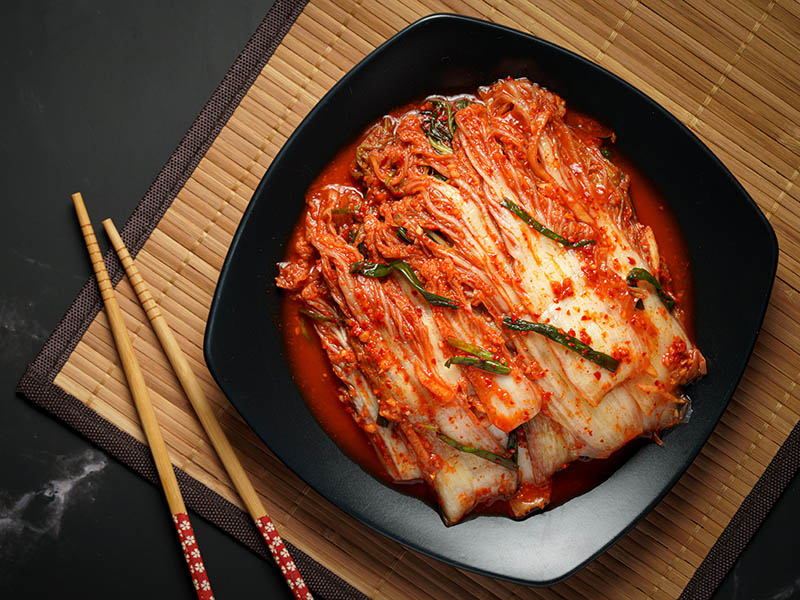
You cannot talk about Korean cuisine without mentioning Kimchi. I think I should finish off this list with one of the world’s most popular Korean side dishes. The history of kimchi is a story of the resilience and resourcefulness of the people of Korea for over 600 years.
The first written record of Kimchi dates back to the Goryeo dynasty (918–1392), which describes the original kimchi ingredient to be radishes instead of Napa cabbages. As agriculture practices prospered and new vegetables were introduced, napa cabbage became a more popular choice.
Though there are more than 200 types of Kimchi, the most popular one is the red, sour, and salty fermented napa cabbage variety. This excellent side dish is good on its own, with boiled pork, rice, ramen and so many other dishes.
There is even a day dedicated to making kimchi in Korea on November 22nd. Making Kimchi bonds neighbor to neighbor and is a communal activity everyone can enjoy.
This practice is a joint effort between neighbors of the same area and is usually prepared by the women of the family. UNESCO has even considered Kimchi-making (Gimjang) an Intangible Cultural Heritage.
Kimchi is one of the most important foods in Korean culture.
Grab A Passport, And You Are Ready To Take On Korean Food
Korean food is something to be celebrated, cherished, and enjoyed in all its authentic glory. The sheer diversity in all ways to prepare simple ingredients is enough to fill a whole library of cookbooks.
If I were you, I’d be booking my plane tickets to go join a tour in Korea right now. I hope you feel empowered to try out new and exciting food not only in Korea but also all around the world.
Like this article, and tell me how many items on this list you have tried before in the comment section. Share this with your friends who have an upcoming visit to Korea or simply just want to know more about Korean foods. See you next time!
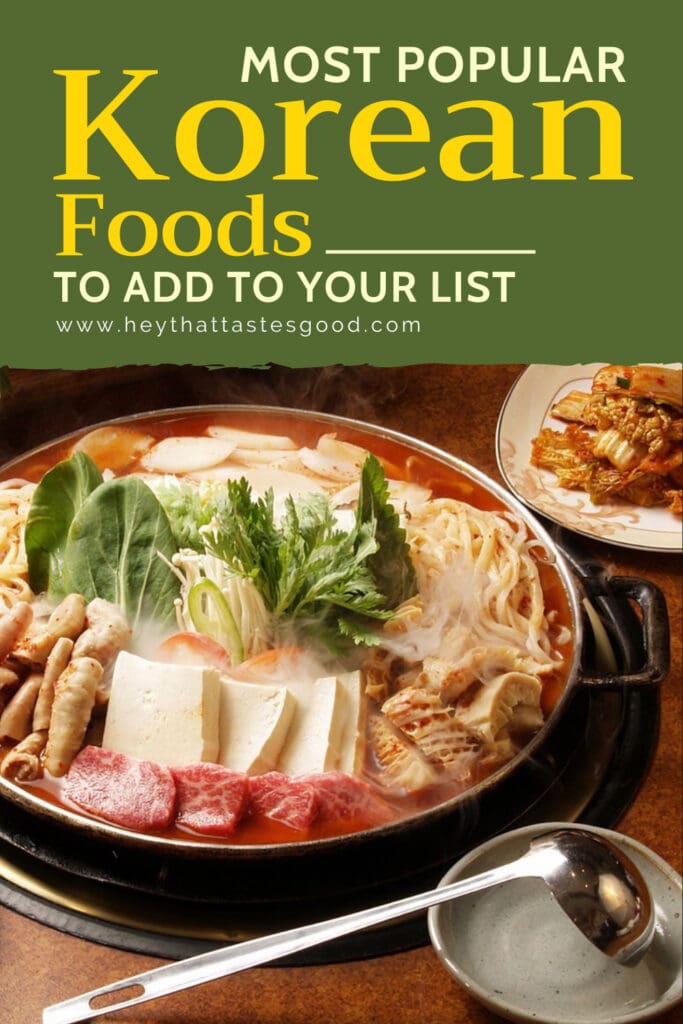


Truc Tran (Kris)
Expertise
Home Cooking, Meal Planning, Recipe Development, Baking and Pastry, Food Editor, Cooking-video Maker, Asian Food Content Creator, Vietnamese Food Evaluation Expert
Education
Program: Diploma of Hospitality (Commercial Cookery)
Focus: The culinary program included a Certificate III in Commercial Cookery, a Certificate IV in Kitchen Management, and a Diploma of Hospitality Management. This education provided a comprehensive blend of theoretical and practical training in finance, sustainability, diversity, and human resources management.
Program: Culinary Arts at Kendall College (Australia Branch in Sydney)
Focus: Explored global cuisines, and developed entrepreneurial abilities to manage a successful food business, along with acquiring essential language, math, computer, and communication skills for success.
Program: Certificate of Vietnamese Cuisine Head Chef
Focus: Master traditional and modern Vietnamese cooking techniques.
Truc Tran, or Kris, is an accomplished food editor with extensive training in hospitality and culinary arts, including a deep focus on Vietnamese cuisine from various prestigious institutions. She possesses over nine years of experience, developing her expertise in global cuisines and blending traditional Vietnamese cooking with contemporary trends to create engaging and educational content.
She also has a rich educational background, including a Diploma of Hospitality from TasTAFE and a Bachelor of Arts in Culinary Arts from Kendall College’s Sydney branch. It enables her to offer unique insights into meal planning, recipe development, and food culture, making her articles and cooking videos both informative and appealing.